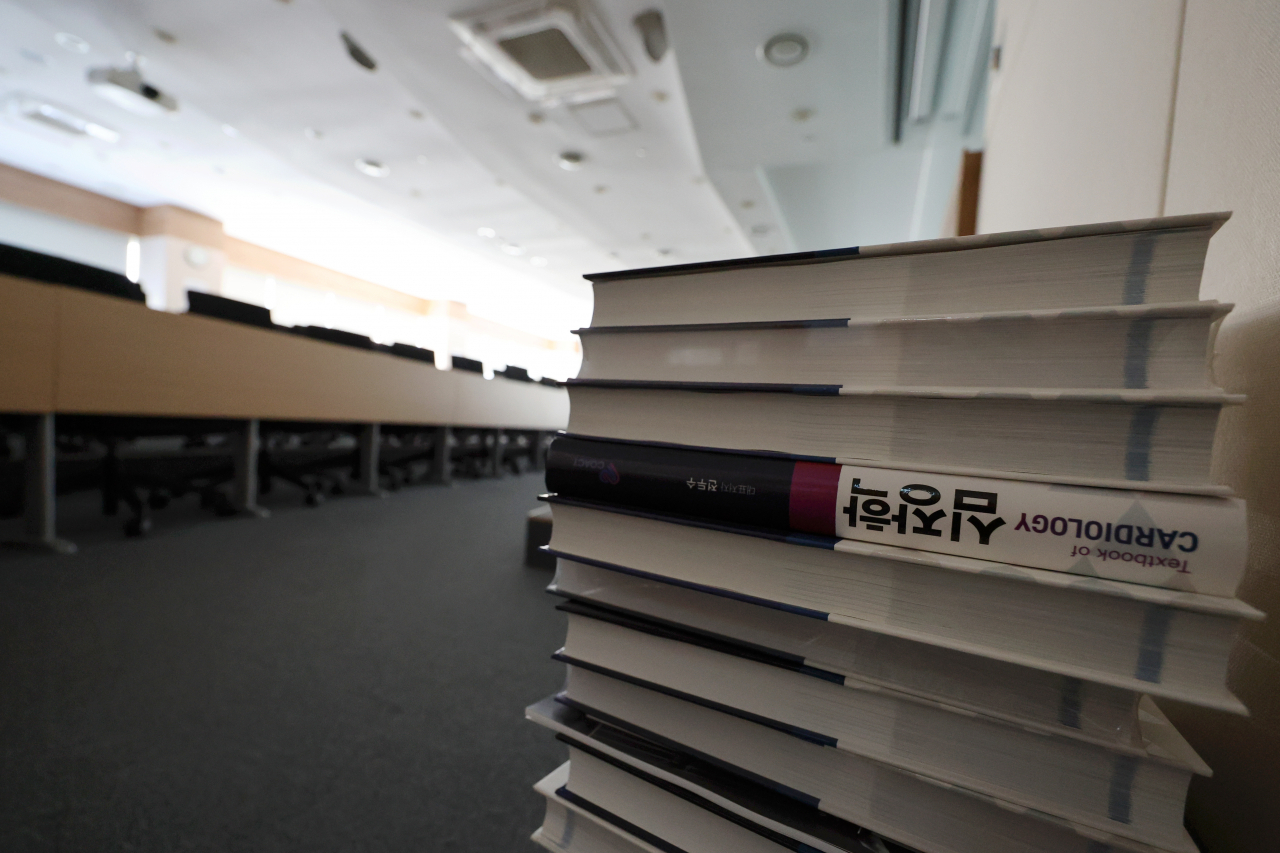 |
Cardiology textbooks are stacked in a lecture hall at a medical school in Seoul, South Korea, Sunday as the medical school enrollment quota hikes for 2025 are set to be finalized. Worries deepen as medical students who have been boycotting classes to protest the increase show no signs of returning. (Yonhap) |
South Korea is set to finalize the implementation of plans for university medical school admissions for the upcoming year, anticipated this week, integrating the government's proposal to augment the annual medical school enrollment quota.
The finalization follows the Seoul High Court's rejection Thursday of an injunction sought by the medical community to halt the plan's implementation. The ruling paves the way for an expansion of enrollment at medical schools, despite vehement opposition from doctors and medical students.
According to the education circle on Sunday, the Korean Council for University Education plans to hold a university admissions committee meeting this week to review and approve the revised plans of each university on how much they will raise their medical school enrollment quotas for the 2025 academic year.
After the meeting, each university will announce its finalized enrollment guidelines on its website by the end of this month, including admission units and majors, the number of applicants it expects to accept, how it will conduct its recruitment and how it will reflect high school students' records and results of the Suneung, Korea's national college entrance exam.
The presidential office on Sunday urged universities to "swiftly complete the process of revising school regulations on the medical school enrollment quota."
Speaking at a press briefing, Jang Sang-yoon, senior presidential secretary for social policy, underscored that the court's decision confirmed the legality and the legitimacy of the state's health care reform process and that the expansion plan is necessary and urgent in the interest of the nation as a whole.
"We are very glad that the uncertainty among parents of the college admission for the 2025 academic year has been resolved," Jang said.
Jang emphasized that the "government will promptly complete the procedures for the changes in the 2025 university admissions plan."
Jang also urged "universities to do their utmost to ensure a smooth admissions process without any disruptions in 2025."
The presidential office also pledged to focus on improving the educational environment for medical schools after the quota hike, such as expanding investment for facilities at regional medical schools.
Among the 32 medical schools allocated additional medical school enrollment slots for next year, 15 universities have completed their revised plans to admit additional medical students next year, including Euljin University, Hallym University, Chonnan National University and the University of Ulsan.
Of the 17 universities that have not completed this process, Ajou University and Inha University have gone through internal faculty and university council procedures to do so, with only the final promulgation processes remaining.
Each university has a slightly different process for revising its bylaws, but most often, the process involves the president of the school announcing a final decision after holding meetings with university and faculty councils.
The government maintains the stance that each university must adhere to the allocation of medical school seats as determined by the education minister in accordance with the Higher Education Act.
As outlined in Article 60 of the Higher Education Act, the ministry may implement corrective measures if schools fail to comply with the state's enrollment plan.
The Higher Education Act also stipulates that the education minister may cancel or suspend the violation of the regulations, reduce the number of students in the school, abolish departments or suspend student admissions.
With the hurdle removed after the court's decision, South Korea will likely see the first increase in medical student admissions in 27 years.
The limit has been capped at 3,058 students per year since 2006, down from 3,507 in 2000, to assuage doctors protesting the policy of separating the prescribing and dispensing of drugs at the time.
If Cha University, which is not required to submit a revised admissions quota as it is a graduate school of medicine, decides to raise its quota by at least 50 percent, or 20 spots, the total enrollment at all medical schools will increase by at least 1,489 and up to 1,509, if it fills 100 percent of the spots.
Speaking at the press briefing, Jang urged trainee doctors and medical students to "return to their positions and actively share their opinions now that the issue of increasing medical school admissions has been settled, even if some aspects remain unsatisfactory."
In a message to medical associations, Jang highlighted that "The government is always open to dialogue," proposing to "meet for the sake of dialogue without any unrealistic preconditions."







![[Today’s K-pop] Blackpink’s Jennie, Lisa invited to Coachella as solo acts](http://res.heraldm.com/phpwas/restmb_idxmake.php?idx=644&simg=/content/image/2024/11/21/20241121050099_0.jpg)